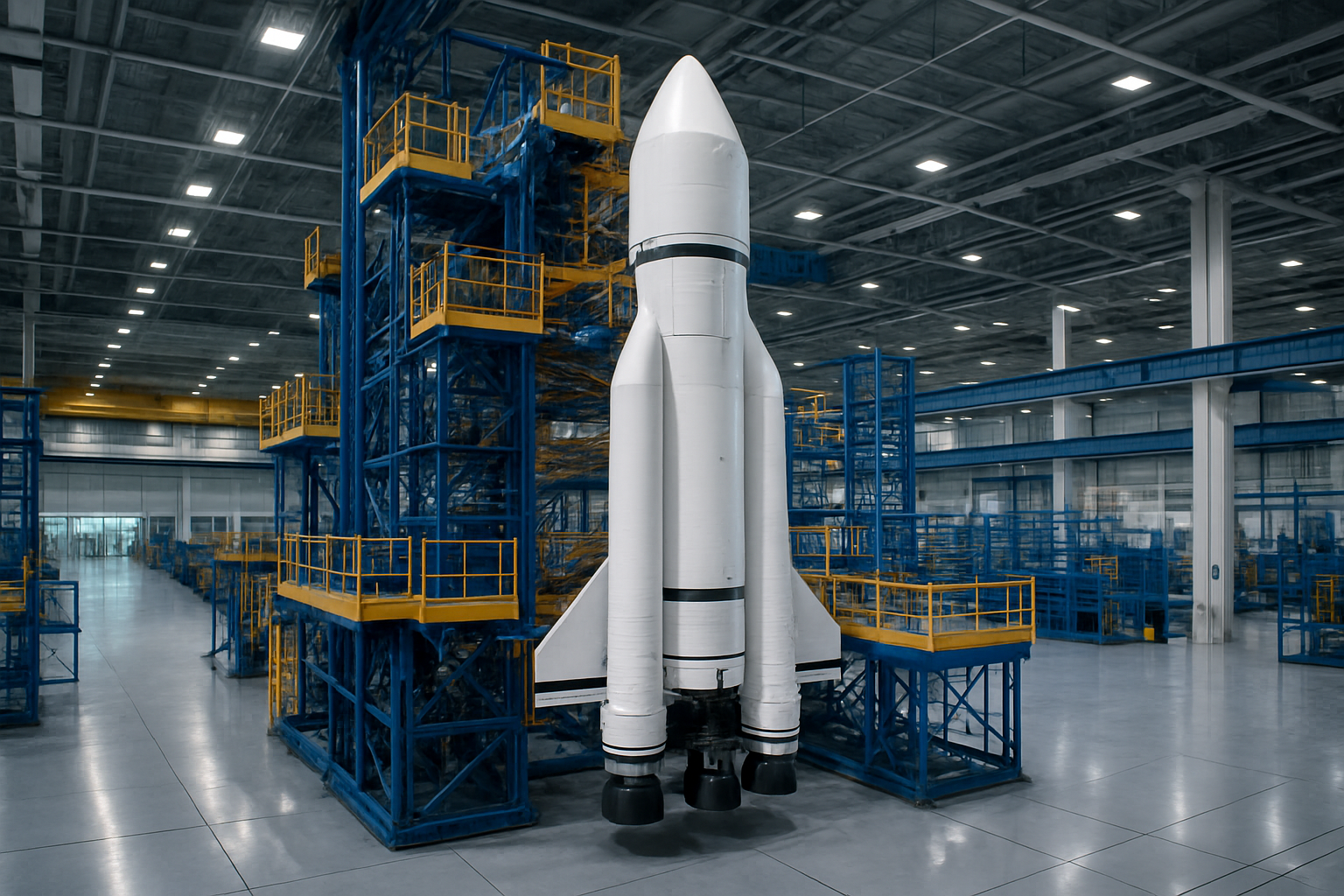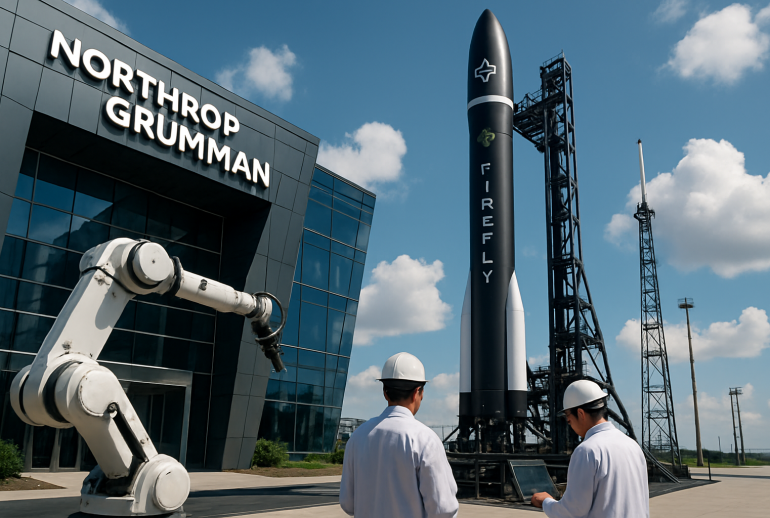In a significant move within the aerospace and defense sectors, Northrop Grumman has recently committed a substantial investment of $50 million to Firefly Aerospace, a company recognized for its pioneering contributions to space innovation. This infusion of capital is designated to accelerate the production and development of the jointly engineered medium-lift launch vehicle, Eclipse, marking a pivotal advancement in commercial and national space operations.
This strategic partnership reflects a growing trend where established defense contractors are increasingly engaging with agile, innovative startups to bolster capabilities in satellite technology and space exploration. Firefly Aerospace’s emphasis on scalable, cost-effective launch vehicles complements Northrop Grumman’s extensive expertise in defense contracting and aerospace technology development. Together, their collaboration aims to enhance the reliability and accessibility of orbital delivery systems amid burgeoning demand.
As global interest intensifies in satellite deployment for communication, earth observation, and national security, investments such as this signify an evolution in how aerospace ventures are financed and realized. The Eclipse medium launch vehicle is envisioned to serve a versatile array of missions, from resupplying space stations to commercial satellite launches and critical defense payload deliveries. This partnership not only exemplifies the fusion of innovation and established industrial prowess but also reinforces the United States’ commitment to sustaining leadership within the space domain.
Northrop Grumman and Firefly Aerospace: A Synergy Driving Space Innovation
The alliance between Northrop Grumman and Firefly Aerospace embodies a fusion of traditional aerospace mastery and startup agility, crucial for advancing modern launch vehicle programs. Northrop Grumman, an industry veteran in defense contracting and aerospace systems, brings decades of expertise in engineering, manufacturing, and managing complex space missions. Firefly Aerospace, established only recently yet driven by groundbreaking technology development, focuses on developing cost-effective launch systems designed around the demands of the contemporary satellite technology market.
By injecting $50 million into Firefly, Northrop Grumman commits not just capital but access to advanced resources, engineering support, and industry networks. This collaboration enables accelerated progress in Eclipse’s design, qualification, and production, targeting significant milestones that will position the vehicle as a game-changer in medium-lift launch capability.
Key Aspects of the Partnership:
- Shared Technical Expertise: Northrop Grumman’s deep knowledge in aerospace systems design complements Firefly’s innovative propulsion and vehicle architecture.
- Joint Development Goals: Both companies co-develop the Eclipse launch vehicle, combining their strengths to deliver reliable and flexible solutions.
- Resource Allocation: Capital from Northrop Grumman fuels testing campaigns, facility upgrades, and production scale-up efforts at Firefly’s headquarters in Cedar Park, Texas.
This synergy reflects a broader shift within the aerospace sector where established contractors are proactively investing in emerging companies that prioritize agility and innovation to meet future space exploration demands. The Eclipse vehicle’s design facilitates a variety of payload profiles, supporting commercial satellites, scientific missions, and national security objectives.
| Company | Role | Contribution | Focus Area |
|---|---|---|---|
| Northrop Grumman | Investor and Technical Partner | $50M investment, engineering support, industry network | Aerospace system integration, defense contracting expertise |
| Firefly Aerospace | Launch Vehicle Developer | R&D in propulsion, vehicle design, facility expansion | Space innovation, satellite launch services |

Advancing Medium-Lift Launch Vehicles for Satellite and Defense Missions
The aerospace industry recognizes medium-lift launch vehicles as pivotal enablers for expanding space infrastructure and satellite deployment. Eclipse, the rocket born from the Northrop Grumman and Firefly Aerospace collaboration, is designed to fill an essential niche between small launchers and heavy-lift vehicles, combining versatility, cost efficiency, and reliability.
This class of launch vehicles offers numerous advantages crucial for space exploration, commercial satellite technology, and national defense. It enables more frequent launch opportunities and can accommodate a wider variety of payload sizes, including critical national security instruments and commercial constellations. Eclipse’s medium-lift capability is engineered to deliver both to low Earth orbit (LEO) and higher orbits, addressing multiple mission profiles.
Main Benefits of Medium-Lift Vehicles like Eclipse:
- Flexibility: Capable of deploying different satellite types and sizes.
- Cost-Effectiveness: Less expensive than heavy-lift alternatives, making space access more affordable.
- Rapid Turnaround: Streamlined manufacturing and launch preparation reduce lead times.
- National Security Utility: Adequate payload capacity for defense apparatus ensures reliable deployment.
Since 2023, Northrop Grumman and Firefly have collaborated on over 60 hot fire tests of the Eclipse’s Miranda engine, a powerful propulsion system engineered to deliver optimal thrust and reliability for orbital insertion. As qualification testing progresses, inaugural flight hardware is nearing completion, signaling readiness for demonstration missions.
| Feature | Description | Impact on Space Missions |
|---|---|---|
| Payload Capacity | Medium-lift (~2,000 – 4,000 kg to LEO) | Supports wide satellite range including commercial and defense payloads |
| Engine Type | Miranda Engine (liquid oxygen and methane) | High-efficiency, reduces carbon footprint and cost |
| Launch Cadence | Multiple launches per year planned | Enables frequent satellite constellation replenishment |
Investment Trends: Established Defense Giants Boosting Space Startups
The $50 million contribution from Northrop Grumman is part of a broader trend where aerospace defense contractors are amplifying their investments in innovative space startups. This strategy synergizes legacy expertise with fresh technology development, fostering rapid commercialization of cutting-edge aerospace systems. In 2025, such investments prove vital as space exploration and satellite technologies experience surging global demand.
Firefly Aerospace’s Series D funding, announced in late 2024, was bolstered significantly by Northrop Grumman’s participation, pushing total raised capital beyond $225 million and valuing Firefly as a major contender in the medium-lift launch vehicle market. This financial backing accelerates production schedules and elevates research capabilities in propulsion and vehicle design.
Key Drivers Encouraging These Investments Include:
- Strategic National Security Needs: Ensuring dependable access to orbit for classified payloads.
- Commercial Satellite Expansion: Meeting global telecom and earth observation demand.
- Technology Development Race: Keeping pace with international space programs and private competitors.
- Economic Growth: Capitalizing on the booming space economy and innovation ecosystem.
Northrop Grumman’s involvement exemplifies a shift towards hybrid developmental models. These bring together startup innovation with the stability and resources of established defense contractors, minimizing risks while fostering breakthroughs.
| Investment Pattern | Examples | Benefits to Aerospace Industry |
|---|---|---|
| Co-development Partnerships | Northrop Grumman & Firefly Aerospace | Accelerated production, shared risk, enhanced technology integration |
| Series Funding Infusions | Firefly Aerospace Series D round | Expanded R&D, market penetration, competitive advantage |
| Defense Contracting Synergies | Northrop Grumman’s broader portfolio | Improved national security space capabilities |
Technological Innovations Driving Firefly Aerospace’s Growth Trajectory
At the heart of Firefly Aerospace’s promise lies its continuous commitment to advancing rocket technology and space innovation. The company’s development of the Eclipse rocket incorporates several technological breakthroughs, especially in propulsion and manufacturing techniques, setting new benchmarks within the space industry.
The Miranda engine is a prime example, utilizing liquid oxygen and methane propellants that offer cleaner combustion and enhanced efficiency compared to traditional rocket fuels. This engine’s performance dramatically reduces operational costs and environmental impact, aligning with broader sustainable aerospace initiatives that are gaining traction in 2025.
Innovations Powering the Eclipse Launch Vehicle Include:
- Additive Manufacturing: Use of 3D printing in engine components accelerates prototyping and reduces manufacturing lead times.
- Modular Design Architecture: Facilitates easier upgrades and adaptability to diverse payload requirements.
- Advanced Avionics: Enhanced onboard systems improve flight control and safety margins.
- Propulsion Efficiency: Methane fuel enables cleaner burning and in-space refuel concepts under study.
These innovations not only enhance Firefly’s technical reputation but directly contribute to lowering barriers for satellite operators and government agencies seeking reliable, affordable launch options. Firefly’s foothold in both commercial and defense contracting arenas is strengthening, enhancing the company’s role as a vital player in 21st-century space exploration.
| Technology Component | Advancement | Benefit |
|---|---|---|
| Miranda Engine | Liq. oxygen & methane propulsion | Higher efficiency, lower emissions, cost savings |
| Additive Manufacturing | 3D printing for complex parts | Faster production, weight reduction |
| Modular Vehicle Design | Interchangeable stages and components | Flexibility for varied missions |
| Advanced Avionics | Improved flight controls and telemetry | Enhanced safety and mission success rates |
Strategic Implications for U.S. Space Exploration and Defense Contracting
The Northrop Grumman and Firefly Aerospace investment resonates beyond technological innovation; it underscores strategic imperatives shaping U.S. space exploration and defense contracting policies. As space becomes the next frontier for geopolitical and commercial competition, strengthening domestic launch capabilities is paramount.
The Eclipse launch vehicle is positioned to support a wide range of missions integral to national and international security, scientific discovery, and commercial enterprise. Reliable access to orbit underpins satellite technology developments enabling intelligence, navigation, and communication networks essential to modern defense systems.
Strategic Advantages Realized Through This Investment Include:
- Enhanced Sovereignty: Ensures American launch capabilities without reliance on foreign providers.
- Commercial Competitiveness: Boosts U.S. standing in a global launch market expected to grow exponentially.
- Resilience and Redundancy: Multiple launch systems reduce risk of operational disruptions.
- Defense Integration: Facilitates timely deployment of advanced defense-related payloads to orbit.
Moreover, this development aligns with broader governmental objectives aimed at increasing public-private collaborations in space programs. By nurturing partnerships with innovative companies like Firefly Aerospace, defense contractors such as Northrop Grumman are helping shape a robust ecosystem capable of meeting future space challenges head-on.
| Strategic Aspect | Impact | Long-term Outcome |
|---|---|---|
| Domestic Launch Capability | Reduces dependence on foreign systems | Increased national security and autonomy |
| Global Market Position | Strengthens U.S. launch competitiveness | Economic growth and technology leadership |
| Operational Resilience | Diversified launch providers | Reduced mission risk and higher availability |
| Defense Payload Deployment | Reliable access for national security missions | Timely and secure defense operations |
Frequently Asked Questions (FAQ)
- What is the significance of Northrop Grumman’s $50 million investment in Firefly Aerospace?
This investment accelerates the development of the Eclipse medium-lift launch vehicle, combining Northrop Grumman’s aerospace expertise with Firefly’s innovative technology to expand U.S. launch capabilities. - What missions will the Eclipse launch vehicle support?
Eclipse is designed to support a broad range of missions, including commercial satellite launches, scientific exploration, space station resupply, and national security payload deployments. - How does the Miranda engine contribute to Firefly’s technology advantages?
The Miranda engine’s use of liquid oxygen and methane fuels leads to higher efficiency, lower emissions, and cost-effective operations, supporting sustainable and reliable rocket launches. - Why are defense contractors investing in space startups?
These investments allow defense contractors to integrate innovative technologies more rapidly, reduce risks through partnerships, and address growing national security requirements in space. - What impact does this partnership have on the U.S. space industry?
It enhances domestic launch capabilities, improves competitiveness in the global market, promotes technological innovation, and supports robust national security space infrastructures.


